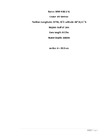| dc.description.abstract | This research presents the planktonic foraminiferal assemblage variation of four western Mediterranean Sea cores since the Last Glacial Termination. The Holocene epoch represents the current interglacial since the Last Glacial Termination ~11,600 cal years ago. Extensive palaeoenvironmental research has verified the ability of planktonic foraminiferal abundances to record climatic and environmental variations. This research utilises planktonic foraminiferal abundance and morphological asymmetry to establish new biostratigraphic applications and to reconstruct Holocene palaeoenvironmental conditions. The chronology of this research is validated by 14C-AMS dating.
The potential of utilising variations in the coiling direction of Globorotalia truncatulinoides as a biostratigraphic tool was first noted in the early 1950s. This research has provided a detailed investigation into the Holocene coiling variation of G. truncatulinoides. Four cores identify a synchronous mid Holocene coiling variation event indicating a change in dominance from the sinistral to the dextral coiling variant. This coiling event was identified ~5.0 cal kyr BP in the initial sampling of the total population of G. truncatulinoides and at the later time of ~ 4.4 cal kyr BP in the faunal abundance record. The synchronous coiling events in all four cores indicate the significance of G. truncatulinoides as a biostratigraphic tool in the western Mediterranean Sea and suggest its possible biostratigraphic significance for other geographical locations. Sea Surface Temperatures (SSTs) were reconstructed for each core via faunal assemblage variations using Artificial Neural Network (ANN) software. Our findings suggest that SSTs was not a controlling factor on coiling direction, but rather ecological conditions relating to water column stability. This finding allows for a palaeoenvironmental reconstruction of the water column as indicated by the abundance and coiling variation of G. truncatulinoides. Three phases of abundance identified the ecological response of the species to environmental changes since the last glacial termination, recording the change from a weakly stratified, stratified and unstratified water column between ~11.2-8.6, ~8.6-5.1 and ~5.1 cal kyr BP-present respectively.
Faunal abundance records established the identification of 3 ecozones (EZ) for the previously undefined areas of the Gulf of Lion and the Balearic Basin (EZ1:11.2-8.6 cal kyr BP, EZ2:8.6-5.1 cal kyr BP and EZ1:5.1 cal kyr BP-present). This new proposed ecozonation provides a means of rapid chronological constraint within a local sub-basin scale. Core M40/4 82-2 SL provided the means to present a high (1-2 cm) resolution palaeoenvironmental reconstruction for the hydrologically significant Gulf of Lion region. SST reconstructions identified three phases of climatic variability and four significant cooling events that can be recognised in both North Atlantic and/or Mediterranean Sea proxies at ~ 7.2, 5.2, 2.4 and 1.2 cal kyr BP. These findings indicate the ability of the Gulf of Lion to record global climatic variations and its potential as a palaeoenvironmental research location. | en |



